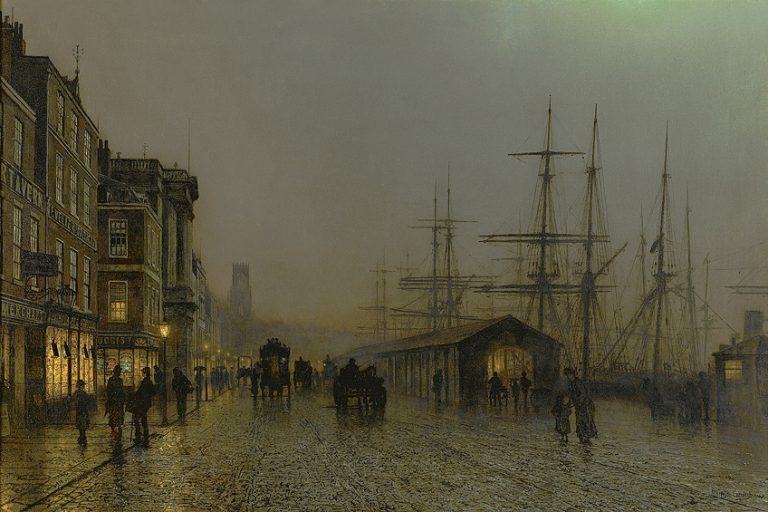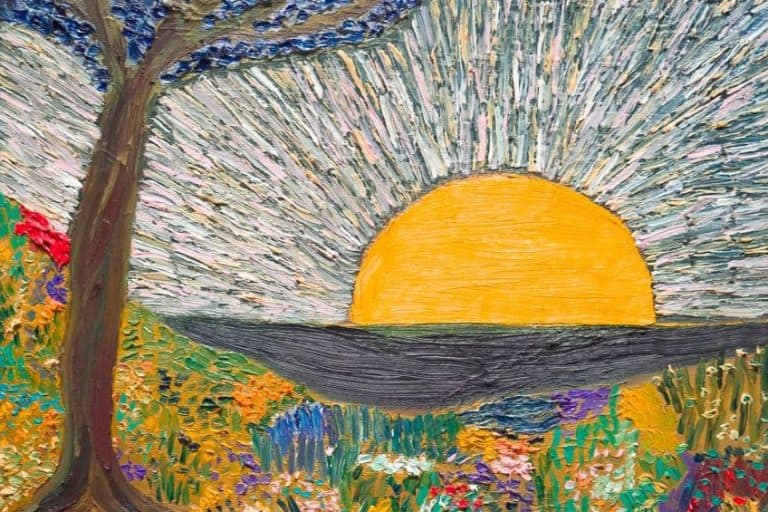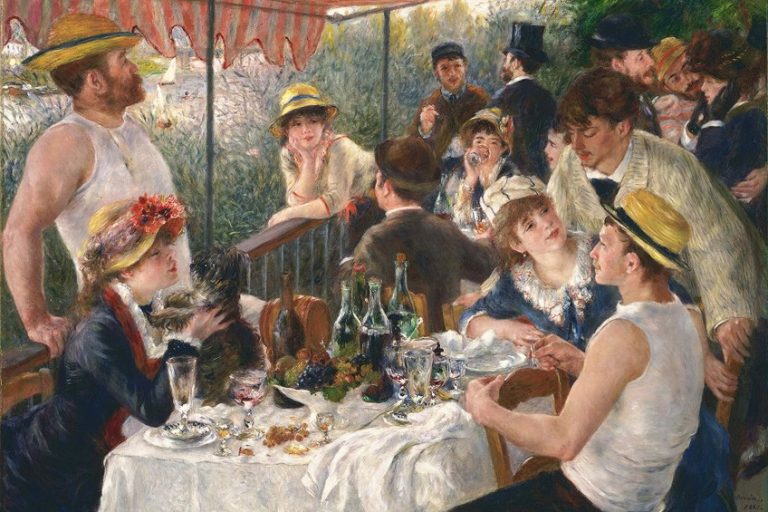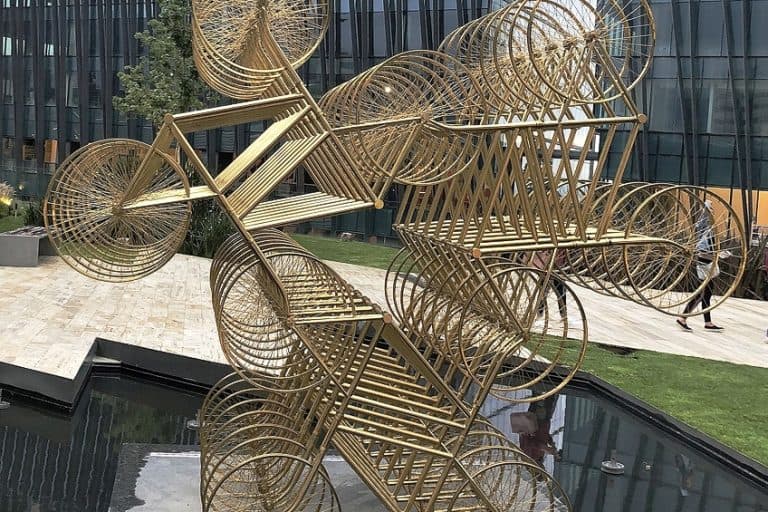Hannah Höch – The Life and Works of Collage Artist Hannah Höch
Hannah Höch was a German Weimar-era artist who was most recognized for her Dada artwork. Hannah Höch’s collage work was referred to as photomontage, a sort of composite in which the glued objects are genuine images or photographic replicas taken from the media and other widely distributed sources. Hannah Höch’s artwork aimed to deconstruct the myth and duality around the notion of the “New Woman”: an energizing, sophisticated, and ambiguous woman ready to assume her rightful position as a man’s equal. Her fascination with the subject stemmed from how the dichotomy was constructed, as well as who constructs societal roles.
A Biography of Hannah Höch
Androgyny, political discourse, and altering gender roles were all prominent subjects in Hannah Höch’s paintings. These themes combined to form a feminist conversation around Hannah Höch’s artworks, which championed women’s emancipation and autonomy throughout the Weimar Republic and still continues now. Her most notable work is Cut with the Kitchen Knife (1919).
| Nationality | German |
| Date of Birth | 1 November 1889 |
| Date of Death | 31 May 1978 |
| Place of Birth | Gotha, German Empire |
Early Life and Training
Hannah Höch was born in the German town of Gotha. Despite the fact that she went to school, domestic life took primacy in the Höch home. Höch was removed from Gotha’s Höhere Töchterschule in 1904 to attend to her younger sister, Marianne. In 1912, she enrolled in studies at Berlin’s College of Applied Arts, where she was mentored by glass artist Harold Bergen. To appease her father, she picked a program in graphic arts and glass design over fine arts. She left the school in 1914, at the onset of World War I, and returned to Gotha to serve with the Red Cross. In 1915, she went to Berlin and enrolled in Emil Orlik’s graphics class at the National Institute of Arts and Crafts.
Höch also started an amorous connection with Raoul Hausmann, a member of the Berlin Dada movement, in 1915. Höch’s engagement with the Dadaists in Berlin began in full in 1917.

Höch, the sole woman in the Berlin group, was picked out for her self-sufficiency, macho demeanor, and bisexuality, as she highlighted issues of the “New Woman’s” freedom to vote, freedom to enjoy and initiate sexual interactions, or financial. Independence. From 1916 through to 1926, she was employed by the publisher Ullstein Verlag in the handicrafts section, producing clothing, needlework, laces, and workmanship designs for various publications.
This early labor and instruction can be seen in many of her collages from the late 1910s to the early to mid-1920s, in which she integrated sewing designs and embroidery motifs.
She worked and lived in the Netherlands from 1926 to 1929. Over the years, Höch built numerous crucial personal and professional contacts with people like Nelly van Doesburg, Sonia Delaunay, and Piet Mondrian, among others. Höch was a forerunner of the art genre that would become known as photomontage.

Personal Life
Höch’s relationship with Raoul Hausmann has been described as “turbulent,” with Hausmann’s unwillingness to divorce his wife cited as the root reason for their squabbles, some of which resulted in violence. He got to the point where he fantasized about murdering Höch.
Hausmann often chastised Höch, not just for her ambition to marry him, which he labeled as an “Upper class” propensity, but also for her artistic beliefs.
Höch was inspired by Hausmann’s false position on women’s freedom to create “a caustic short fiction” titled “The Painter” in 1920, about an artist who is thrown into a deep spiritual dilemma when his wife asks him to clean the dishes. Hausmann constantly intimated that having a child with him was the only way Höch could realize her full potential as a female and in their relationship.

Höch desired children, but she underwent abortions both times she became pregnant with Hausmann’s baby, in May 1916 and January 1918. Höch’s romance with Raoul Hausmann terminated in 1922. Höch met Dutch author and linguist Mathilda Brugman through common acquaintances Kurt and Helma Schwitters in 1926 and started a relationship with her in 1927. By the fall of 1926, Höch had moved to The Hague to reside with Brugman, where they remained until 1929, after which they relocated to Berlin. Höch and Brugman were together for nine years, until 1935.
They did not characterize their connection as lesbian, instead referring to it as a discreet love affair. Höch started a relationship with Kurt Matthies in 1935, and they were married from 1938 until 1944.
Later Years
Höch lived in Berlin, Germany, during the Third Reich, maintaining a low profile. She was the final component of the Berlin Dada collective to stay in Germany at the time. She purchased and resided in a tiny garden home in Berlin-Heiligensee, a rural location on Berlin’s outskirts.
She was subjected to Nazi regulation of artwork, and Hannah Höch’s artwork was labeled “perverted art,” making it even harder for her to exhibit her work. Despite the fact that her art was not as well-received after the war as it was before the emergence of the Third Reich, she proceeded to create photomontages and show them abroad until her death in Berlin in 1978.

The Dada Art Style of Hannah Höch’s Collages
Dada was an art concept that began in Zurich, Switzerland in 1915. The movement was anti-monarchy, military, and conservatives, and it was deeply rooted in an “anti-art” mindset. Dadaists believed that art should be free of restrictions and that it should be humorous and fun. These sentiments emerged in the aftermath of the Great War, which drove society to doubt the role of government and to denounce militarization in the face of war’s atrocities.
Many Dada works criticized the Weimar Republic and its unsuccessful attempt to establish democracy in post-World War One Germany. In terms of bourgeois culture, the Dada phenomenon had a fundamentally negative tone. The name “dada” has no genuine meaning; it is only a childish phrase used to indicate the lack of explanation or logic in most of the artwork.
John Heartfield, George Grosz, and Raoul Hausmann are among the key painters associated with the movement.

Some argue that it was Höch’s friendship with Hausmann that enabled her to enter the world of Dada artists. John Heartfield and George Grosz were opposed to Höch showing alongside them at the First International Dada Fair in 1920, and only permitted her to participate when Raoul Hausmann lobbied for her involvement. Höch’s photomontages are her most well-known work. Hannah Höch’s Collages, which drew images from popular culture and used image deconstruction and reassembly, matched well with the Dada aesthetic, while some Dadaists were reluctant to embrace her work owing to the movement’s intrinsic misogyny.
Her art provided a “wryly feminist tone” to the Dadaist concept of contempt for bourgeois society, but her gender identification and feminist source material resulted in her not being completely embraced by the masculine Dadaists.
Hannah Höch’s paintings, like that of other Dada artists, was closely scrutinized by the Nazis because it was deemed degenerate. The Nazis halted her planned show at the Bauhaus in 1932. They were upset not just by her appearance, but also by her ideological sentiments and the fact that she was a female. Hannah Höch’s collages depicted androgynous people, which the Nazis loathed. Nazi ideology admired artwork depicting the idealized Aryan German male and lady.
Hannah Höch’s paintings frequently contrasted this appearance or used it to convey a social point, such as in the painting The Beautiful Woman (1920). The Nazis favored a conventional, straightforward, reasonable form of art that did not need in-depth study or analysis. They considered the Dada style’s turmoil to be pathological. Höch retreated into isolation during the Nazi era but was able to go back to the art world once the Third Reich fell.
Photomontage
Höch’s photomontages depict the turmoil and conflagration of Berlin’s visual culture, with a focus on women. Höch wasn’t just a remarkable female operating significantly in the art in the early 20th century unique as a female involved in the Dada movement that crystallized during her time – but she also intentionally advocated the notion of women engaging artistically in society more broadly.
She directly tackled the problem of gender and the role of the female in modern society in her groundbreaking photomontage artwork. Höch took pictures and text from common media forms, such as magazines and newspapers, and merged them in frequently eerie ways to reflect her opinions on key social topics of the day in these montages.
The photos she used in her works were taken from contemporary newspapers and periodicals, lending credibility to her words.
The purposeful disintegration and rebuilding of images contributed to the works’ potency. This refers to the idea that current situations may be viewed through several glasses. This method was once seen as particularly communist and radical, but by the 1930s, it had become a widely recognized manner of design associated with modernism and consumerism.
Thus, the idea was born that popular culture and the arts may be meaningfully united.
Her work’s ambiguity was essential to how she tackled questions of human sexuality. Gender constructs that are more complex permit women to appreciate both their masculinity and femininity. This heightens the sensation of individuality. Photomontage is an important aspect of Höch’s artistic heritage.
Female Artists in Dada
While the Dadaists talked of women’s freedom, they were plainly hesitant to admit a woman to their ranks. According to Hans Richter, Höch’s contributions to the Dada movement were the “food, beer, and cappuccino she managed to summon up despite the lack of money.” Raoul Hausmann even proposed that Höch obtain a job to help him financially, despite the fact that she is the only one in her inner group with a steady salary.
In response to her marginalization and the Dadaists’ misogyny, Höch stated, “None of these gentlemen were pleased with merely an average lady.”
However, they were not involved in the decision to forsake the traditional male/masculine morality toward women. Informed by Freud, in defiance of the elder age, they all sought this “New Woman” and her trailblazing determination to freedom. They, on the other hand, vehemently opposed the concept that they, too, needed to acquire new mindsets.

This resulted in these really Strindbergian plays that characterized these men’s personal matters.” Höch was the only female member of the Berlin Dada group, while Beatrice Wood and Sophie Taeuber were other prominent, albeit underappreciated, Dada players. Höch’s photomontage, Da-Dandy, alludes to the cynicism of the Berlin Dada movement and German culture as a whole. Höch also wrote on the hypocrisy of males in the Dada group in her short piece “The Painter,” which was published in 1920 and depicts a modern pair that accepts equality between the sexes in their relationship, a fresh and disturbing concept at the time.
This is an instance of Höch’s ability to transcend one medium and transmit her societal values in a variety of ways.
Höch’s tenure at Ullstein Verlag, where she worked with women’s magazines, made her painfully aware of the disparity between women as depicted in culture and their realities, and her workspace provided her with many of the photos that functioned as raw resources for her own works.

She was also scornful of the concept of marriage, frequently representing brides as dummies and toddlers, reflecting the widely held social belief that women are imperfect beings with no influence over their life. Between 1916 and 1926, Höch was employed by the magazine Ullstein Verlag in the section that concentrated on design trends, crafts, knitwear, and needlework, creative practices within the domestic realm considered acceptable for women.
“The patterns Höch made for Ullstein’s women’s periodicals and her early explorations with modernist abstraction were inextricably linked, blurring the barriers between conventionally male and female modalities of form and representation”. In 1918, she published a Manifesto of Contemporary Embroidery, which addressed the modern woman, enabling her to take pleasure in her work.
“She now relied on this experience, as well as a massive amount of commercial material she had gathered, in pictures that were unparalleled in their observations into the way civilization ‘structures’ women”.
Höch identified with the women’s movement in the 1920s, as evidenced by her portrayal of herself in Cut With the Kitchen Knife (1920). Her pieces frequently mix male and feminine characteristics into one united person. During the Weimar Republic, “masculine-looking women were both lauded and condemned for challenging established gender norms.”
Höch symbolically compares her scissors, which she uses to cut pictures or collages, to a kitchen knife in this piece. In Weimer culture, this is used to represent piercing through the dominating spheres of public life. Her androgynous qualities may have been influenced by her bisexuality and interest towards masculinity in women, i.e., attraction to the feminine form combined with traditionally masculine traits.
Hannah Höch’s Artworks
Höch was a forerunner of the photomontage art genre as well as the Dada movement. Many of her paintings satirized the popular mass beauty business of the period, which was gaining substantial traction in the media due to the advent of fashion and commercial photography. Many of her Dada-era political works associated women’s freedom with economic and social upheaval. Hannah Höch’s paintings depict the turmoil and explosion of Berlin’s contemporary arts through the eyes of a woman. Her photomontages, in particular, frequently satirized the Weimar New Woman by combining pictures from contemporary periodicals.
Her paintings from 1926 to 1935 frequently showed same-sex couplings, and women were a recurring motif in her works from 1963 to 1973. Her most often employed procedure was the fusion of masculine and female bodies.
This fusion exists in order to offer a woman the attributed authority of a male while also blurring the limits of gender-associated activities. In Hannah Höch’s Collages, she also employed traditionally feminine techniques such as embroidery and lacework to accentuate gendered connotations. Höch also spoke out strongly against racial prejudice. Cut with the Kitchen Knife, a 1919 satire of Weimar Germany, is her most renowned work. This work incorporates photos from the time’s newspapers, which have been blended and re-created to produce a fresh statement on life and artwork in the Dada era.
One of Höch’s most ambitious and politically charged projects, From an Ethnographic Museum (1929), consists of twenty photomontages that juxtapose images of European feminine bodies with pictures of African men’s bodies and face masks from museum collections, resulting in collages that provide “the visual cultural identity of two hugely separate human civilizations as indistinguishable modish European flapper ends up losing nothing of her classiness in close vicinity to Various African artifacts.
Likewise, the nobility of Dada Dolls was made by Höch in 1916. Hugo Ball, the Zurich-based originator of Dada, influenced these dolls. The doll’s clothes were modeled after the geometric shapes of Ball’s personal clothing, which he wore in pivotal Dada performances.
Dada, as a movement, was essentially political. Dada artists frequently utilized political humor to highlight current concerns.
They strove to push art to its human boundaries in order to represent the chaos of post-war (World War I, which had not yet been given this term) Germany. “Many of Höch’s explicitly political photomontages parodied the new republic’s supposed socialism and connected female freedom with leftist political revolution.” Perhaps Höch’s most well-known collage, Cut with the Kitchen Knife, represents her cutting through the patriarchal system.
The work is a clear critique of the Weimar Republic’s unsuccessful effort at democracy.
“An intense aggregation of cut-up pictures, smack dab in the midst of the most well-known image of the foundational First International Dada Fair in 1920,” says the artist of the collage. This photomontage is a great example of a composition that incorporates three of Höch’s main themes: androgyny, the “New Woman,” and political discourse. It blends pictures of elected figures with sports stars, as well as robotic cityscapes and Dada painters.
In principle, women in Weimar Germany had a new freedom to explore societal, cultural, and self-definition – all of which were significantly discussed by Höch. Notwithstanding this, there were several concerns with women’s socio-economic situation. Women were granted more independence, but in a manner that appeared set for them. They were nonetheless limited to specific professions and had fewer employment perks than their male peers. Beautiful Woman (1920), by Höch, demonstrates the creation of the paradigm of the “New Woman.”
The image incorporates themes of the idealized feminine figure as well as automotive components. A woman’s face with cat eyes may be found in the upper right corner. With industrialization comes the potential for women to participate more fully in the labor field. While this was an exciting prospect for females, it was also scary, as depicted by the cat’s eyes peering down at the picture.
This illustration demonstrates that, while women were enthused about the concept of the “New Woman” and the liberty that lifestyle may provide, it was an emancipation that was still built by males, who still held the majority of power in society.
Marlene (1930) hints to the subject’s unclear sexual identification. The artwork portrays two men staring up at a pair of legs in stockings and high heels perched on a pedestal. This pedestal represents traditionalism, while the legs represent how sexuality prevailed over classical architecture. The top right corner’s lips reveal a feminine sexiness that is hidden from the masculine gaze.
The sculpture might give the viewer the notion of a utopian time that resists gender hierarchies. “Her androgynous photos show a joy in shifting between gender orientations as well as an intentional breakdown of conventional male and feminine characteristics.”
These concepts were radical at the moment Höch expressed them, yet they are still being addressed today. Androgyny may be seen as a utopian ideal in Hannah Höch’s artworks; it also links to some of her extreme leftist ideals and the political rhetoric that surrounds them.
Famous Artworks
Höch was equally fascinated by the portrayal of women as mannequins, dummies, and marionettes, as well as mass-produced objects. During her Dada period, she created and displayed stuffed dolls with accentuated and abstracted features that were nonetheless plainly recognized as feminine. In the late 1920s, she incorporated advertisements for famous children’s dolls in numerous distressing photomontages, such as Love (1926) and the Master (1925). Here is a list of a few of her most well-known pieces:
- Cut with the Kitchen Knife (1919)
- The Beautiful Girl (1920)
- Marlene (1930)
- Mother (1930)
- Strange Beauty II (1966)
Recommended Reading
Would you like to learn more about Hannah Höch’s artworks and biography? Well, then why don’t you read even more about this amazing artist by purchasing a book! Here is a list of our recommended books about the artist.
Hannah Höch: Picture Book (2010) by Gunda Luyken
Hannah Höch is most recognized for her revolutionary photomontage paintings, which briskly contrast mechanistic and organic shapes, ancient and modern bodies, emblems and language culled from logos and headlines, while also including feminism, commodities critique, and other political themes. “It is astonishing how current much of Höch’s work feels to us,” Luc Sante recently remarked, “in its sexual politics, comedy, and exuberant exploitation of everything and anything at hand.”
- A full-color children's book from the famous German photo-collagist
- The story chronicles the adventures of four mythical creatures
- Combines photomontage with hallucinatory plant imagery
Hannah Höch (2014) by Dawn Ades
This book on the renowned Dada artist Hannah Höch delves into her use of collage as an artistic medium for both parody and emotional beauty. Hannah Höch, world-renowned for her works during the Weimar era, was a pioneer in many creative and cultural fields. She was a pivotal female artist in the Berlin Dada movement, which destroyed sound, language, and pictures and reassembled them into new elements, writings, and interpretations. Höch was a crucial figure in the evolution of collage, laying the groundwork for today’s widespread image-altering techniques.
- An exploration of Hannah Höch's use of collage as an artistic medium
- Focusing on Höch's collages whilst analyzing her full artistic oeuvre
- Looking at Höch's use of collage for both satire and poetic beauty
Hannah Höch, a staunch supporter of artistic freedom, questioned conventional notions of collaboration, beauty, and the creation of art, her work providing sharp critiques of ethnic and societal prejudices, notably those of her home Germany. her quick development of an individual style was both hilarious and frequently poignant, but also provided a critical reflection on society during a period of significant social upheaval.
Frequently Asked Questions
Who Was Hannah Höch?
Hannah Höch was a Weimar-era German artist best known for her Dada work. Hannah Höch’s collage work was dubbed photomontage, a type of composite in which the pasted elements are authentic photos or photographic duplicates collected from the media and other widely circulated sources. Hannah Höch’s works sought to demolish the myth and dichotomy around the concept of the so-called New Woman.
What Kind of Art did Hannah Höch Create?
Hannah Höch’s paintings featured important themes such as androgyny, political discourse, and shifting gender roles. These ideas coalesced to establish a feminist debate centered on Hannah Höch’s artworks, which advocated for women’s liberation and autonomy during the Weimar Republic and continues to this day. Her most well-known piece is Cut with the Kitchen Knife (1919). Höch’s photomontages show the upheaval and chaos of Berlin’s visual culture, with a concentration on women. Höch was not only a great female artist working in the early twentieth century – unusual as a female participant in the Dada movement that solidified during her time – but she also actively promoted the idea of women engaging artistically in society more widely.
Isabella studied at the University of Cape Town in South Africa and graduated with a Bachelor of Arts majoring in English Literature & Language and Psychology. Throughout her undergraduate years, she took Art History as an additional subject and absolutely loved it. Building on from her art history knowledge that began in high school, art has always been a particular area of fascination for her. From learning about artworks previously unknown to her, or sharpening her existing understanding of specific works, the ability to continue learning within this interesting sphere excites her greatly.
Her focal points of interest in art history encompass profiling specific artists and art movements, as it is these areas where she is able to really dig deep into the rich narrative of the art world. Additionally, she particularly enjoys exploring the different artistic styles of the 20th century, as well as the important impact that female artists have had on the development of art history.
Learn more about Isabella Meyer and the Art in Context Team.
Cite this Article
Isabella, Meyer, “Hannah Höch – The Life and Works of Collage Artist Hannah Höch.” Art in Context. March 7, 2022. URL: https://artincontext.org/hannah-hoch/
Meyer, I. (2022, 7 March). Hannah Höch – The Life and Works of Collage Artist Hannah Höch. Art in Context. https://artincontext.org/hannah-hoch/
Meyer, Isabella. “Hannah Höch – The Life and Works of Collage Artist Hannah Höch.” Art in Context, March 7, 2022. https://artincontext.org/hannah-hoch/.













